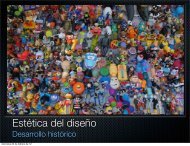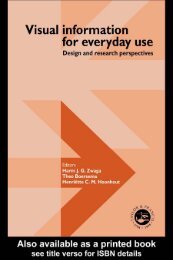Edited by Chris Jenks - carlosmoreno.info
Edited by Chris Jenks - carlosmoreno.info
Edited by Chris Jenks - carlosmoreno.info
You also want an ePaper? Increase the reach of your titles
YUMPU automatically turns print PDFs into web optimized ePapers that Google loves.
AN INTRODUCTION<br />
To abstract implies a removal, a drawing out from an original location, and<br />
an enforced movement of elements from one level to another. Abstraction,<br />
then, involves the transposition of worlds; an extracting of essences, or<br />
elements, or generalities from one original plane into another. The new<br />
world, the created level, the (re)presentation, provides the potential arena for<br />
the manipulation and control of images. Images become infinitely malleable<br />
once freed from their original context, whilst still retaining significations<br />
within that original context (as poetry, hermeneutic theory, modern art and<br />
advertising all know—for good or ill). Because, for some and on some<br />
occasions, the strategies of refining, adjusting, displacing and enhancing<br />
images that occur through abstraction may generate unwelcome ‘sights’, the<br />
whole process can sometimes be indicted as a practice of reification.<br />
Whether or not we take heed of this last criticism, abstraction undoubtably<br />
leads us through a series of problematics which are unsettling in their<br />
implications. Through the practice of abstracting phenomena from one plane,<br />
locus or level up onto another visual dimension, we are led to ask ‘which<br />
image should we finally attend to?’, or indeed, ‘which image (re)presents the<br />
world?’ Such questions pitch us into, what Hegel might have termed, ‘a<br />
whirling circle’ of uncertainty, which derives, in part, from the essentially nonconsensual<br />
character of socio-cultural theory. We are confronted with a set of<br />
questions concerning representation which are not wholly dissimilar to those<br />
which have beset art history when it attempts to explain painting’s relation to<br />
its social context. As Bryson has put it in his debate with Gombrich:<br />
To the question, what is painting? Gombrich gives the answer, that it is<br />
the record of perception. I am certain that this is fundamentally wrong.<br />
...It is a natural enough attitude to think of painting as a copy of the<br />
world, and given the importance of realism in Western painting it is<br />
perhaps inevitable that eventually this attitude would be elevated to a<br />
doctrine…what is suppressed <strong>by</strong> the account of painting as the record of<br />
perception is the social character of the image, and its reality as sign. 25<br />
Here, we are essentially questioning the level at which a particular theory,<br />
or scopic regime, seeks to concentrate and thus suspend, or hold, its signs:<br />
for theory always gives supremacy to a particular level. Art history might<br />
see this as, for example, an issue of figuration, abstract expressionism,<br />
conceptualism, hyperrealism or whatever.<br />
Sociology, far from being a shared and happy perspective on social<br />
reality, is, rather, fragmented and competitive. This dispersion and<br />
challenge quite appropriately, though not exhaustively, reflects what Schutz<br />
would regard as the infinite ‘multiple realities’ that comprise all human<br />
experience. Different paradigms within sociology, then, producedifferent<br />
worlds just as different scopic regimes of modernity, or different<br />
rationalisations of sight have fashioned our cultural ‘outlook’. The world<br />
9






